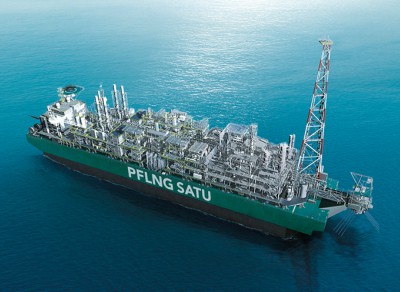Petronas to export world's 1st LNG from floating production unit
SINGAPORE (Reuters) -- Malaysia's Petronas is about to export the world's first LNG produced from a floating production unit, according to shipping data and people familiar with the matter, beating rivals like Royal Dutch Shell in a race that has cost developers billions of dollars.
 |
| Photo Courtesy of Petronas. |
The Petronas Floating LNG Satu (PFLNG Satu), sitting off the coat of Bintulu on Malaysia's Borneo island, is currently loading LNG into the 144,000 cubic meter capacity LNG tanker Seri Camellia, according to trade sources and shipping data in Thomson Reuters Eikon.
"Now, Satu is loading up a tanker, which will leave within the next day or two, making Satu the world's first LNG that was produced from a floating platform," one source close to the matter said, declining to be named due to the commercial sensitivity of the deal.
Eikon data shows that the LNG tanker arrived on March 25 and has started loading the LNG cargo. Traders with knowledge of the matter said that PFLNG Satu's first export cargo was heading for South Korea.
Petronas declined to comment.
The Satu facility, which is estimated to have cost as much as $10 B, arrived in those waters last year, preparing for first operations.
Other producers currently developing floating LNG production facilities include Royal Dutch Shell, which with the over-$12 B Prelude FLNG is building the world's biggest maritime vessel for use in Australia. Japan's Inpex is building a similarly big FLNG unit as part of the $37 B Ichthys export project, also for use in Australia.
Both these hugely expensive projects have been plagued by delays, allowing Petronas to become the first company to produce LNG from a floating production unit.
The huge development costs have led some to question whether FLNG units on this scale will be ordered again in future.
The LNG industry is undergoing huge change as the biggest ever flood of new supply is hitting the market, with volumes coming mainly from Australia and the United States.
The oversupply resulted in a more than 70 percent fall in Asian spot LNG prices from their 2014 peaks to around $5.50 per MMBtu.
The Satu project's progress boosts Petronas' credibility as a firm able to engineer and execute cutting-edge projects, said Prasanth Kakaraparth, senior upstream analyst at energy consultancy Wood Mackenzie.
"Petronas enters a super-elite club of global players with FLNG capability," said Kakaraparth. "But with spot prices looking to trend below $5/MMBtu, this is a very tough environment to be bringing on new supply."
Reporting by Henning Gloystein; Additional reporting by Mark Tay in SINGAPORE and Emily Chow in KUALA LUMPUR; Editing by Kenneth Maxwell

- ExxonMobil halts 1-Bft3d blue hydrogen project in Texas
- Aramco and Yokogawa commission multiple autonomous control AI agents at Fadhili gas plant
- Ukraine will resume gas imports via Transbalkan route in November
- Mitsubishi to inject $260 MM into Brunei LNG project
- Freeport LNG (U.S.) on track to take in more natgas on Thursday after unit outage



Comments